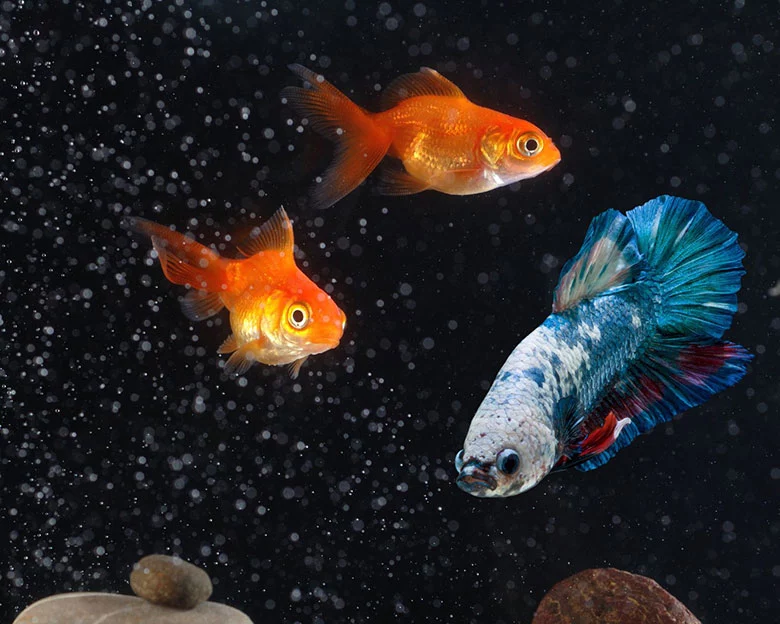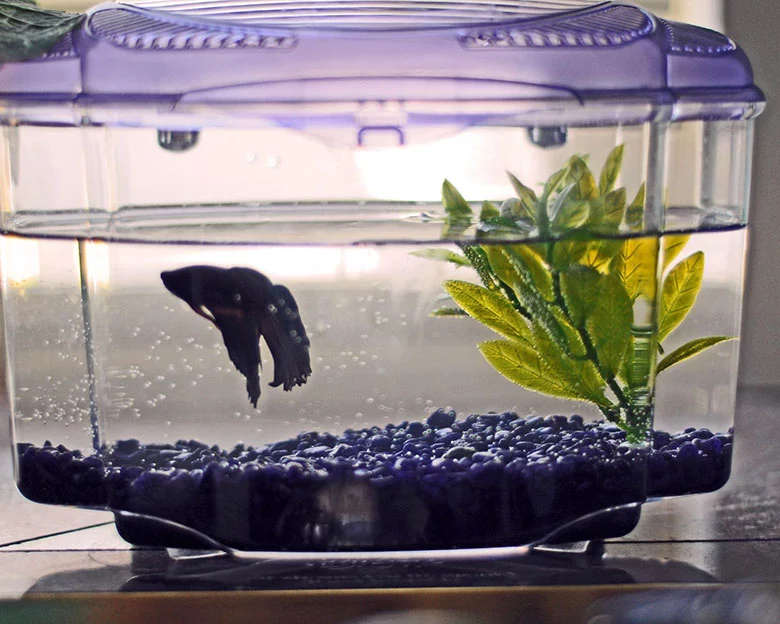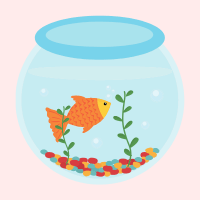Are you considering adding both a Betta Vs Goldfish to your aquarium? While these two species are some of the most popular pet fish, their compatibility is a common question among fish keepers.
It’s important to understand each species’ unique behaviors, water requirements, and territoriality before deciding to coexist them together.
In this article, we will explore the compatibility between bettas and goldfish, providing you with data-driven, scientific information to help you make an informed decision. With expert advice and resources, we’ll delve into the differences in their water requirements, tank size and setup, aggression and territoriality, and potential health risks.
By the end, you’ll have a better understanding of whether these two species can coexist in the same aquarium and how to ensure their well-being.
Key Takeaways
- Bettas and goldfish have different water requirements, with goldfish needing cold water and bettas needing warm water with proper filtration, lighting, and heating.
- Goldfish are notoriously dirty and produce a lot of waste, while bettas are sensitive to ammonia spikes and require clean water.
- Male bettas are highly territorial and aggressive, while goldfish have a reputation for fin-nipping.
- In the long-term, goldfish and bettas are not suitable tankmates and should be kept separately. Temporary housing in a quarantine tank is recommended if needed.
Compatibility Differences
You may have learned that bettas and goldfish have different water requirements, which makes it difficult for them to coexist in the same tank. Betta fish are tropical fish that require warm water, while goldfish are coldwater creatures. Additionally, goldfish produce a lot of waste, which can make the water in the tank dirty and unsuitable for bettas.
Another factor that makes it challenging for bettas and goldfish to coexist is their temperament and behavior. Male bettas are highly territorial and aggressive, and they may attack and injure goldfish. Goldfish, on the other hand, have a reputation for being fin-nippers and may damage the delicate fins of bettas.
Therefore, it’s not recommended to keep bettas and goldfish together in the same tank for the long-term.
Water Requirements
To ensure the health and wellbeing of your pet fish, it’s important to consider their specific water requirements.
Betta fish are tropical and require warm water between 75-82°F, which means they need a heating system. Goldfish, on the other hand, prefer cooler temperatures between 65-68°F and don’t need a heating system, but they do need a cooling system to keep the water temperature stable.
pH levels and calcium content are also important factors in water requirements. Bettas prefer soft water with little or no calcium content (kH) and a pH level between 6.5-7.5. Goldfish prefer water with a higher pH level in the range of 7.2-7.6, which has a higher calcium content. This is because goldfish require more minerals in the water to help with their bone growth and development.
It’s important to monitor and maintain the proper pH levels and calcium content for your fish to ensure their long-term health and wellbeing.
Tank Size and Setup
When considering the tank size and setup for keeping both bettas and goldfish, it’s important to keep in mind the specific needs and preferences of each species.
Bettas require at least a two-gallon tank with an efficient filter system, proper lighting, and heating to maintain a warm and stable environment. Goldfish, on the other hand, need a much larger tank of at least 20 gallons due to their size and need for ample swimming space.
In addition to tank size, decor options should also be taken into consideration. Bettas prefer heavily planted aquariums with lots of hideouts and resting places to reduce stress and provide a sense of security. Goldfish, on the other hand, prefer open water with lots of swimming space.
Temperature control is also crucial as bettas need warm water while goldfish prefer cooler water.
It’s important to note that keeping bettas and goldfish together in the long-term is not recommended due to their different water requirements and behaviors.
Aggression and Territoriality

If you put a betta and a goldfish together, it’s likely that one of the fish will become aggressive towards the other due to their territorial nature.
Bettas are known to be highly territorial and aggressive towards other fish, especially if they perceive them as a threat. On the other hand, goldfish are also territorial but are more likely to bully other fish by nipping their fins. In some cases, the betta may attack the goldfish or vice versa, leading to serious injury or even death.
Understanding the behavior of bettas and goldfish is crucial to maintaining a peaceful aquarium environment. Tank decorations and hiding spots can help reduce aggression by providing both fish with their own territory.
Bettas prefer heavily planted aquariums with lots of hideouts and resting places, while goldfish prefer open water with lots of swimming space. By creating separate areas for each fish, you can minimize the chances of aggression and create a harmonious environment for both species.
However, it’s still not recommended to keep bettas and goldfish together in the long-term, as their different water requirements and behavior make it difficult to maintain a healthy and happy aquarium for both fish.
Stress and Water Changes
Maintaining a healthy environment for your pet fish can be a challenge, especially when it comes to reducing stress and managing water changes. Both bettas and goldfish are sensitive to changes in their environment, and sudden fluctuations can put them at risk of developing illnesses or even dying. Therefore, it’s essential to keep a close eye on these factors to ensure your fish stay healthy and happy.
To reduce stress in your betta or goldfish, you should provide them with a calm and peaceful environment. Avoid placing their tank near noisy areas or where there’s a lot of foot traffic. Also, make sure that their tank is appropriately sized, has enough hiding places, and is kept clean.
Water chemistry is another crucial factor in reducing stress, and it’s essential to monitor the pH, nitrate, and ammonia levels in your aquarium. Regular water changes, ideally once a week, can help maintain stable water chemistry and keep your fish healthy.
Remember, a happy and healthy fish is a fish that lives in a stress-free environment.
Potential Health Risks
Moving on to potential health risks, it’s important to note that cohabiting bettas and goldfish can lead to serious health issues for both species. As mentioned earlier, goldfish produce a lot of waste and require frequent partial water changes to maintain a healthy environment. However, bettas are highly sensitive to ammonia spikes and can easily succumb to ammonia poisoning. This means that if you house a betta in a tank with goldfish, the water quality may quickly deteriorate, putting the betta’s health at risk.
Moreover, bettas and goldfish may also carry different diseases and parasites that can be transmitted to each other. To minimize the risk of disease transmission, it’s crucial to quarantine any new fish before introducing them to an existing tank. This means setting up a separate tank for the new fish and keeping them isolated for a period of time to observe for any signs of illness. In the table below, we’ve highlighted some of the common diseases and parasites that can affect bettas and goldfish, and the potential consequences of cohabitation without proper quarantine measures.
| Disease/Parasite | Symptoms in Bettas | Symptoms in Goldfish | Potential Consequences |
|---|---|---|---|
| Ich | White spots on fins and body, lethargy | White spots on fins and body, flashing | Can be fatal if left untreated |
| Velvet | Gold or rust-colored dust on skin, lethargy | Gold or rust-colored dust on skin, flashing | Can be fatal if left untreated |
| Fin Rot | Ragged or frayed fins, lethargy | Ragged or frayed fins, lethargy | Can lead to secondary infections and fin loss |
| Dropsy | Swollen, bloated appearance, pineconing scales | Swollen, bloated appearance, pineconing scales | Can be fatal if left untreated |
| Columnaris | White patches on skin, lethargy | White patches on skin, lethargy | Can lead to secondary infections and death |
Cohabiting bettas and goldfish may seem like a convenient solution, but it can actually lead to serious health risks for both species. To ensure the well-being of your fish, it’s important to provide them with appropriate living conditions and to quarantine any new additions to your tank. By taking these measures, you can help prevent the spread of disease and provide a healthy environment for your fish to thrive in.
Short-Term Emergency Solutions

In case of an emergency, you can temporarily house your betta in a separate quarantine tank to ensure its safety. This is a short-term solution that can be used if you need to replace the filter unit in your goldfish tank or if your betta is showing signs of illness.
A quarantine tank should be set up and cycled before use, and it should have a heater and filter to maintain optimal water conditions. Bettas are sensitive to water changes, so it’s important to make sure the water parameters in the quarantine tank match those in the betta’s original tank.
While it’s not recommended to keep bettas and goldfish together in the long-term, there are some alternative tankmates that can coexist with bettas. Some examples include snails, shrimp, and small schooling fish like neon tetras or rasboras.
However, it’s important to research each potential tankmate to ensure they have similar water requirements and won’t pose a threat to the betta’s safety. In any case, it’s always best to have a separate tank prepared for emergencies and to avoid risking the health of your beloved betta.
Expert Advice and Resources
If you’re looking for expert advice and resources on fishkeeping, there are many online communities and forums where experienced fish keepers can share their knowledge and answer your questions. Some of the most popular ones include Fishlore, Aquarium Advice, and The Planted Tank Forum.
These online communities are a great way to connect with other fish hobbyists, get advice on everything from tank setup to fish health, and learn about the latest trends and technologies in the world of fishkeeping.
Expert opinions can be invaluable when it comes to figuring out the best way to care for your fish, but it’s important to be aware of common misconceptions as well.
For example, many people believe that goldfish can live happily in a small bowl with no filtration or heating, but this is far from the truth. Goldfish actually require a lot of space and a well-maintained filter system to stay healthy and happy.
Similarly, some people believe that bettas are aggressive and can’t live with any other fish, but this is not always the case. With careful planning and the right tank setup, bettas can coexist with a variety of other fish species.
By doing your research and seeking out expert advice, you can create a thriving aquarium that brings you and your fish joy for years to come.
Frequently Asked Questions
Can Goldfish And Bettas Breed Together?
Breeding compatibility between bettas and goldfish is not possible due to their genetic differences. They belong to different families and cannot interbreed. It is important to understand the biology of fish before attempting to breed them together.
Can Bettas And Goldfish Live Together In A Pond?
While it’s possible for bettas and goldfish to live together in a pond, there are potential challenges of mixing species. Goldfish produce a lot of waste, which can harm bettas, and bettas may attack the fins of goldfish. However, with proper care and monitoring, pond cohabitation can provide benefits such as natural pest control and a more diverse ecosystem.
Do Bettas And Goldfish Have Different Dietary Requirements?
Bettas and goldfish have different dietary requirements. Goldfish thrive on a varied diet of flakes and pellets, while bettas require a protein-rich diet of live or frozen foods. Despite this, they are not compatible in a community tank.
Can Goldfish And Bettas Be Kept In The Same Tank If They Are Both Juveniles?
Compatibility concerns arise when keeping goldfish and bettas together in the same tank, regardless of their age. Tank size requirements for each species differ significantly, and the water parameters necessary for their health are also vastly different.
What Are Some Potential Behavioral Indicators That A Betta And Goldfish Are Not Getting Along?
If a betta and goldfish are not getting along, potential indicators include aggressive behavior, such as chasing and biting, as well as territorial disputes over food and space. It is important to separate them to prevent harm.

